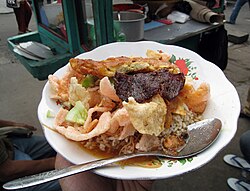Nasi ulam
This article includes a list of references, related reading or external links, but its sources remain unclear because it lacks inline citations. (February 2013) |
 | |
| Course | Main course |
|---|---|
| Place of origin | Indonesia[1][2] and Malaysia[3] |
| Region or state | Jakarta, Bali and Sumatra in Indonesia; Malay peninsula in Malaysia |
| Associated national cuisine | Indonesia and Malaysia |
| Main ingredients | Steamed rice dish mixed with various herbs |
| Variations | Rich variations across the respective region |
Nasi ulam is a traditional Betawi and Malay dish of steamed rice (nasi) served with various herbs and vegetables (ulam),[3] commonly found in Indonesian and Malaysian cuisines. The herbs being used especially the leaves of pegagan (Centella asiatica) or often replaced with kemangi (lemon basil), vegetables, spices and accompanied with various side dishes.[2] This dish is a feature of Betawi[2] and Malay cuisine with many variations and is commonly found in Indonesia, Malaysia, Singapore and southern Thailand. Nasi ulam often served with sambal chilli paste.
Variants[]
Indonesia[]
In Indonesia, nasi ulam can be found in Betawi (native Jakartans) cuisine[1] as well as Sumatran Malay and Bali.[4]
In Jakarta there are two types of nasi ulam, the wet (soupy) nasi ulam of northern and central Jakarta, and dry one of southern Jakarta. In Indonesia, nasi ulam usually spiced with kemangi herb, chili, sliced cucumber and sprinkled with peanuts granule, kerisik (grated and sauteed coconut) or serundeng. An array of other additional dishes are often added on top of nasi ulam, such as dendeng (beef jerky), telur dadar (omelette), perkedel (mashed potato fritter), fried tofu or tempeh, and krupuk.[5]
Malaysia[]
Nasi ulam in Malaysia consist of cold boiled rice that is mixed with shredded herbs such as daun kaduk (wild pepper leaf), pucuk gajus (cashew leaf shoots), onions etc. Kerisik and other spices are also added. Sometimes shredded fried fish is mixed in. This version is common in northwest Peninsular Malaysia. A type of nasi ulam in northeast Peninsular Malaysia, in which the rice is dyed blue, is called nasi kerabu.
See also[]
- Ulam (salad)
- Nasi bogana
- Nasi campur
- Nasi goreng
- Nasi kebuli
- Nasi kerabu
- Nasi kucing
- Nasi kuning
- Nasi lemak
- Nasi liwet
- Nasi pecel
- Nasi tim
- Nasi uduk
References[]
- ^ Jump up to: a b Rizky Tyas Febriani. "Nasi Ulam Betawi". warisanbudaya.kemdikbud.go.id (in Indonesian). Retrieved September 9, 2020.
- ^ Jump up to: a b c Post, The Jakarta. "Where to go for authentic Betawi cuisine". The Jakarta Post. Retrieved September 6, 2020.
- ^ Jump up to: a b "Nasi ulam, Infopedia". eresources.nlb.gov.sg. Retrieved September 6, 2020.
- ^ Digital, Prodik (September 10, 2020). "Makanan Khas Bali di Harris Hotel Sentul City". Tempo. Retrieved September 13, 2020.
- ^ "Perpaduan kultur dalam seporsi nasi ulam betawi". (Indonesian)
- Indonesian rice dishes
- Betawi cuisine
- Malay cuisine
- Malaysian rice dishes